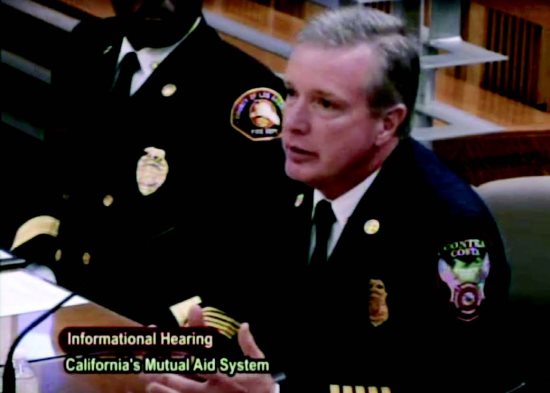
| ||||||
Speaking at a Feb. 27 hearing in Sacramento, Carman, as president of the California Metropolitan Fire Chiefs Association, asked a senate committee for $100 million to beef up the California mutual aid system, an interagency agreement to provide emergency assistance when requested. The funds would go toward increased staffing of overloaded dispatch centers, upfront deployment of resources during predictable weather events and an upgrade to the cumbersome state tracking system with newer, quicker software.
"We're operating under a 50-year-old system. Things have changed in the last 50 years, and before, we depended on mutual aid to get us mutual aid in the first 12 to 24 hours. Now we need them in the first minutes to hours," Carman said.
The chief said that at the start of the Napa and the Southern California wildfires, ConFire had resources ready to go, but the district was unable to send crews or engines for hours because it had not received an official order. "That was as frustrating as you can imagine," Carman told the committee. "The system became overwhelmed."
Carman often kidded that each year, he would predict the worst fire season ever. But he wasn't joking in Sacramento. "How long are we going to call these fires unprecedented, when we continue to have them year after year after year? Soon they will become the norm," the chief said.
Under Carman's proposal, local agencies would put together strike teams in advance of major, predictable weather events, rather than wait for resources to be assembled and deployed after a fire starts. Should a major wildfire roar over the Lafayette Ridge into Upper Happy Valley, or jump Bear Creek Road into north Orinda, local agency strike teams would be able to deploy instantly, without overwhelming the dispatch and ordering systems. Fire chiefs would be able to pay the local strike teams without relying on local funding, which doesn't exist, according to ConFire Deputy Chief Lewis Broschard, the system's operational area coordinator.
The $100 million to pay for this upfront staffing would come through the state cap and trade program, which charges penalties to companies that exceed allowable greenhouse gas emissions. Carman drew a connection between cap and trade and wildfires in that the amount of carbon dioxide released into the atmosphere from the Napa and Southern California fires equals what every car in California emits in two years. The sooner a fire is put out, the fewer pollutants in the air.
In 2017, Cal Fire received $200 million from the greenhouse gas funds through the Governor's Office of Emergency Services, which manages the state mutual aid system. Local districts received $25 million. But most of the mutual aid comes from local agencies, like ConFire and the Moraga-Orinda Fire District, which regularly send out engine companies in response to mutual aid requests. Carman said that state officials were unaware of how little money trickles down to the local agencies.
But hope appears on the horizon, as Carman said that Gov. Jerry Brown wants to meet with local fire officials. "So after eight years of totally ignoring local government fire agencies, and after two years of giving us a fraction of our ask, we at least have his attention," Carman said.
Reach the reporter at:
